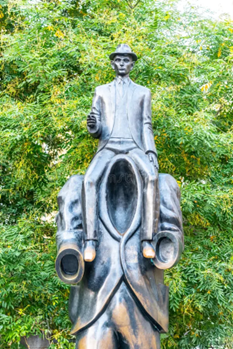
With the discovery of Jewish art and culture my heritage became more significant.
Franz Kafka Memorial. Unusual Sculpture in Jewish Quarter, Prague.
In January 2019, I with my daughter, Ariel, took an intensive tour of our European Jewish Heritage. Oddly, we did not go to visit the birthplaces of my parents—Bialystok in Poland and Zaslav in the Ukraine. Those areas had been cleansed of Jews, and their habitats and synagogues by packs of aggressors ranging from the rage of Cossacks, Germans, Russians, and the denizens of the locals.
My daughter sensibly planned the trip to dock in Vienna and Prague where we would tour cities which were not ravaged as much by the Second World War. The older areas with historic buildings and décor survived. Vienna had indeed considerable damage, but Prague’s Jewish identity was well preserved in its original synagogues, clogged Jewish cemetery, and relative tolerance of Jews settlement before the war and afterwards.
We wanted to visit the synagogue services but had not known that it required a security check that would last over three days. The Jews in Vienna still felt vulnerable especially because the synagogue had been attacked by terrorists some years before. In addition, we discovered that the Jewish population who returned to Austria after the war truly loved Austria but were still suspicious of the Austrians.
Despite this feeling and the limits imposed by security issues, Vienna unexpectantly laid the foundation for our emotional preparedness.
To my surprise, the Museum of Art and Industry primed my mind for discovering my heritage in a prism that eliminated emotions of past prejudice.
The entrance to the building is designed to open one’s emotions to freedom and inspiration: the floor of a chamber supports an array of yoga pads that covers an estimate of 90 square yards. Sacks suspended forty feet in the ceiling were filled fill with air and then released it in a synchronized pattern. One can time breathing in harmony with these “lungs” on high. There are many visitors on the floor in silence breathing with you. It reminded me of a religious séance or a Zen Buddhist meditative experience. By shutting your eyes, you are encouraged to feel that you are entering a new universe. Breathe in, breathe out. For me, this was the threshold for choosing many paths in my mind’s roundabout to my past.
As a Jew whose parents had suffered greatly in pogroms, and relatives who had been murdered in the Nazi death camps, Europe was identified primarily by the Holocaust. I was brought up identifying its history with anti-Semitism. Norman Cohen’s magnum work, The Pursuit of the Millennium argued that “the ideologies of Communism and Nazism, dissimilar though they are in many respects, are both heavily indebted to that very ancient body of beliefs which constituted the popular apocalyptic lore of Europe.” His compelling thesis was driven by the view that European history which began after the fall of the Roman Empire was relentlessly the engine of genocide.
Vienna and Prague softened my negative views of Europe. I came to admire the history of the Jews who despite their oppression created an admirable civilization for themselves and with others. Despite their travails, they carved out their own worlds of beauty, joy, and even creativity.
Prague introduced me to the history of the Kabbalah or Jewish mysticism in early European history. The exhibition of the lives and the texts of these orthodox Jews revealed the achievements and strength of this community despite being cursed as threatening aliens. They produced exquisite artwork of sculpture, silver engravings, textiles, glass, music and synagogue architecture equal to the best in Europe.
I had always been infatuated with the writings of Franz Kafka who was a Prague native. I looked forward to touring his memorial museum. I could have spent a lifetime reading manuscripts, looking at old photographs, and talking with the docents. Especially significant for me was to learn that though he wrote in German, he disliked that language and preferred Czech. I read a letter where he expressed his anger toward the German language, particularly in the word for mother which sounded so cold and so unemotional. In his writings and use of language he epitomized the archetypical Jew who precariously balanced on two worlds.
The Museum’s commentary on Kafka’s The Trial, explained that this work was a Kabballah parable employing a mystical base to relate philosophical issues of life and death. A passage from Kafka has become part of my lifelong journey: “No matter where we are at the end of our lives, never let it be said that we wished for the beginning, and in the beginning of our lives, never wish it would end.” For me, the meaning of this was that the purpose of life was living fully without remorse.
This medieval statue represents the connection between the body and the soul. Kafka’s statute in the prompts’ title features Kafka on the shoulder of a headless body. a body. This symbolic representation of the body draws upon the mysticism of Jewish spirituality. My trip into the past circulated around to appreciate my own upbringing in the faith, culture and mysticism of Judaism.


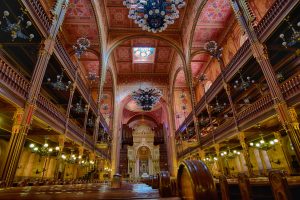
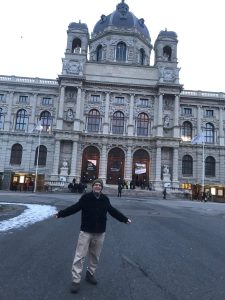
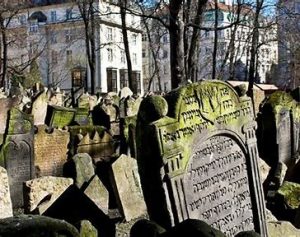


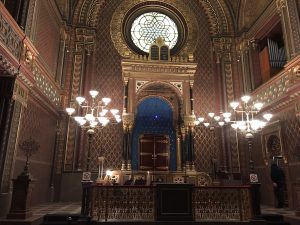
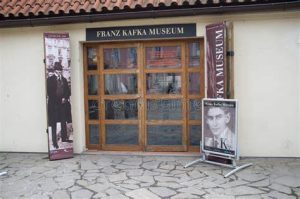

Richard, thank you for this very enlightening essay. I spent a little time in Vienna in early 2008, but did not get to the synagogue. I did go to a Jewish museum (as we might have discussed), but found the people there were NOT friendly, quite suspicious of me (I could not communicate with them to let them know that I am Jewish). It was a most unpleasant experience. We hope to travel to Vienna and Prague sometime soon (within the next few years) and this story solidifies that desire.
Your description of being inside the giant lung in the Vienna Museum of Art was remarkable. You said the artist was “Sacks”; is that American artist Tom Sacks? I am curious because I’ve seen a good bit of his work and been in his studio.
Thank you for all your commentary here.
Betsy: thank you for your comments and careful reading. I have been warned about using the passive voice. Originally I had written “Sacks were suspended.” But the reader wanted to know who suspended them. I was not aware that Sacks was also an artist.
Yes, Austrian Jews are very suspicious. Not only of future terrorists but also of old antisemitic attitudes. Bernstein canceled at least one of his performances in Vienna when he learned how many ex Nazis played in the orchestra. He did conduct at other times.
AS I mentioned, I was surprised that one famous female Jewish artist who had fled then returned after the war to Vienna, scribbled on her paining:
I love Austria but distrust the Asturians.
Fortunately do speak rudimentary Yiddish and German. So language was not a problem.
Richard
Now I understand that “Sacks” were things, not a person. And you were learn from my story that I know two “Sacks” who are artists. The one I write about in my story does not live in NYC.
Thanx Richard for sharing your personal and moving story. I’ve not been to Vienna or Prague and your experiences remind me they are two cities high on my bucket list.
And thanx for the Kafka quote. I agree with your interpretation.
This visit sounds very moving and full of insights into history, the present and artistic expressions reflecting those realities. How fortunate to have made those connections. Thanks for your posting.
Khati: my trip was influenced my own feelings as the child or immigrants who were repressed, discriminated against, and even murdered. This feeling has transferred to my trips in East Asia Asia where I learned about the Taiwanese, the Koreans suffering in Japan, and the Koreans under martial law.
Richard, I was deeply moved by your visit to the Museum of Art. What an inspiring entrance. It reminded me of the beginning of my meditation experience when I had difficulty in obtaining the stillness I wanted. I kept my favorite quotes nearby and would reach for one to focus on. One that I still use to this day is by Kafka, “You do not need to leave your room. Remain sitting at your table and listen. Do not even listen, simply wait, be quiet still and solitary. The world will freely offer itself to you to be unmasked, it has no choice, it will roll in ecstasy at your feet.” I think this quote can also sum up the wonderful trip to your past. Your daughter was an excellent planner.
Paztty
Thank you for the Kafka quotation. It fits right5 into my story.
My daughter has always been a great guide–to China, Hong Kong, Japan, Europe in general, Mexico, and Taiwan. Later I will tell stories about my wife, Anna, and I in some of the same places. All with pleasure and discovery.
I did not include in my trip the visit to Terezin, the concentration camp that ultimately sent thousands to their death. I did not do this because it brought up the obvious comparison with the way we treat the refugees and illegal immigrants from Mexico–separating children from their parents, creating situations where people die in the desert, pushing children back into the river to drown, and including the building of Potemkin Village schools for visitors such as Melania Trump which display how well we are treating the children. This discussion was not totally relevant to my story. But it played a part when I returned home.
We took this same journey several years ago. Thank you for bringing back so many poignant memories.
A novel take on the connotations of European culture, history and politics, Richard. So often we simply stand agog at the iconic works of western civilization without recognizing, or even knowing of the undertones that, as you say, began to rumble through Europe from before the middle ages. How does one separate medieval art from witch hunts and inquisitions?
I was particularly moved by your description of the breathing exhibit in the Vienna Museum of Art. Also, the notion of a perpetually terrified Franz Kafka who hated the sound of the language he was compelled to write in.
Also, from the beginning of your piece, such a wise choice not to land in the ravaged land of your ancestors. My wife Susan’s people also came from the area you describe, which was leveled by the Germans early on.
A moving and unique take on what could have been just another European summer, had you ignored the shadows and the bones just underfoot. Thanks!
Thank you Charlie for your ibnsightful comments. I did leave out my trip to Terezin for the future prompt on separating families. Oh, that will be my introduction to the damages of US and Texas/Florida immigration policies.
Your observations on the deep-runnng roots of antisemitism in Eastern (and all) Europe meshed with read I’ve been doing on the history of Russian/Soviet fascism. Have you read this guy ? Ilyian, an early Russian proto fascist? He came up with young Lenin and Stalin and then sided with the Whites after 1917. Now in fashion with pUtin and oligarchs…
“Ilyin had anticipated a different transition from Soviet to Russian power: fascist dictatorship, the preservation of all Soviet territory, permanent war against the sinful West. Russians began to read him in the 1990s. His ideas had no effect on the end of the Soviet Union, but they did influence how post-Soviet oligarchs consolidated a new kind of authoritarianism in the 2000s and 2010s.”
— The Road to Unfreedom: Russia, Europe, America by Timothy Snyder
https://a.co/fEtLXoR
If the Jews who returned to Austria remain suspicious of the Austrians, I can only imagine what the Jews now in Germany feel like.
And that is, fittingly, a disturbing statue!